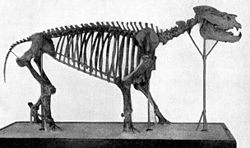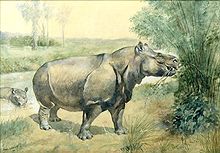- Metamynodon
-
Metamynodon
Temporal range: Late Eocene–Early Miocene
Metamynodon planifrons skeleton Scientific classification Kingdom: Animalia Phylum: Chordata Class: Mammalia Order: Perissodactyla Family: †Amynodontidae Genus: †Metamynodon
Scott & Osborn, 1887Type species †Metamynodon planifrons Species - †M. planifrons
- †M. chadronensis
- †M. mckinneyi
Metamynodon is an extinct genus of amynodont perissodactyls, and is among the longest lived genera of amynodonts, having first appeared during the late Eocene, and becoming extinct during the early Miocene, when it was supplanted by the semiaquatic rhinoceros, Teleoceras. Its fossils have been discovered in the United States (White River Fauna), Mongolia and China.
Characteristics
Metamynodon was about 4 metres (13 ft) in body length, and, although it was distantly related to the modern rhinoceros, looked more like a hippopotamus. Its front legs had four toes instead of the three found in modern rhinos. Although it was a herbivore (as indicated by its teeth), its skull had a bony ridge typically associated with carnivorous mammals. It probably fed on tough plant material, and the jaw muscles were attached to this ridge. Metamynodon would have used its enlarged canines to search for food in river banks, and may also have had highly flexible lips. Its eyes were placed high on the skull, meaning that it would have been able to see while almost fully submerged, much like a hippopotamus or crocodile.[1]
References
This prehistoric odd-toed ungulate-related article is a stub. You can help Wikipedia by expanding it.


